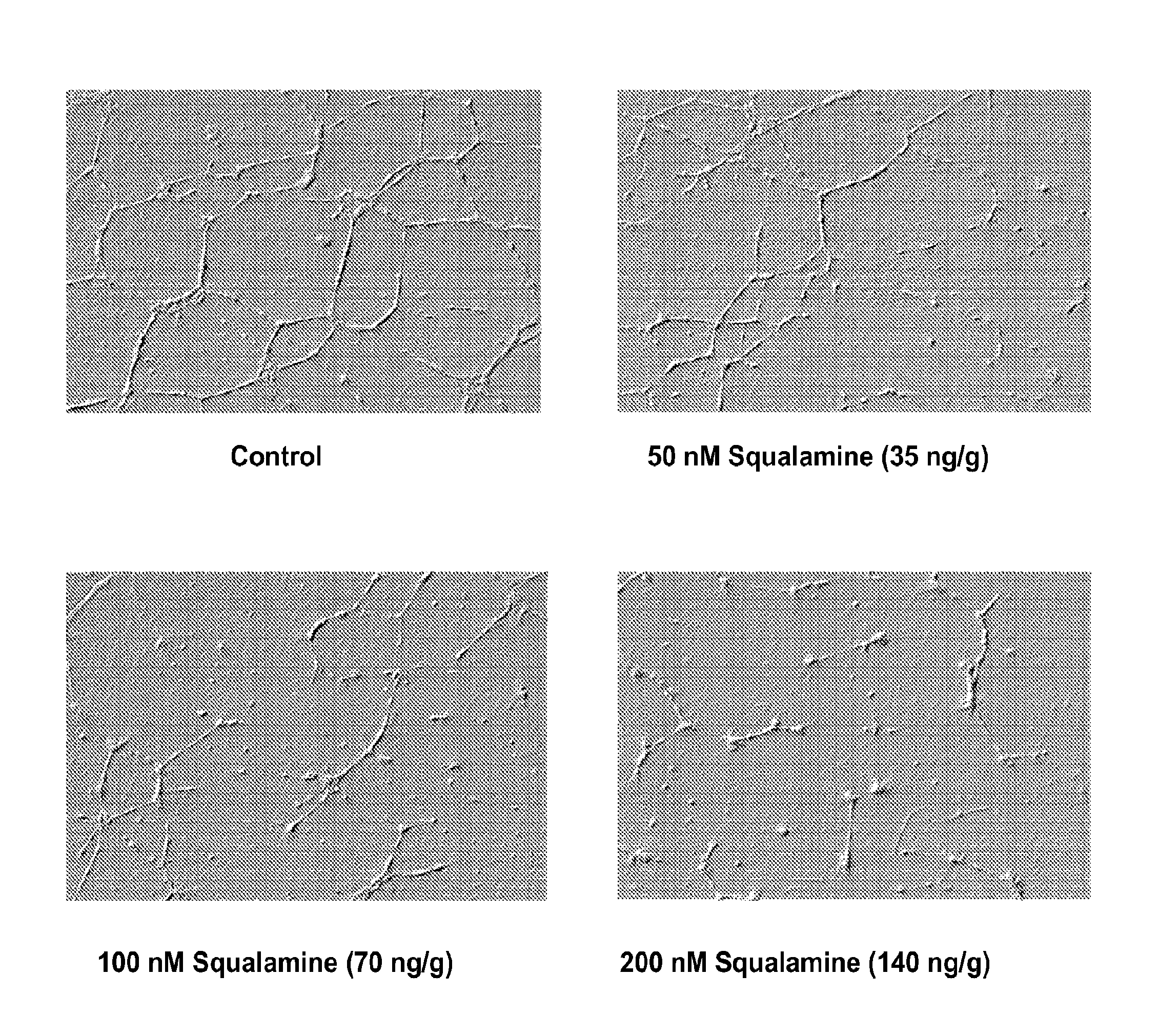Ophthalmic Formulations of Squalamine
a technology of ophthalmic formulations and squalamine, which is applied in the field of ophthalmic formulations of squalamine, can solve the problems of serious complications, endophthalmitis and retinal detachment, and the inability of the pigment epithelium of the macula to remove waste materials generated by the retina
- Summary
- Abstract
- Description
- Claims
- Application Information
AI Technical Summary
Benefits of technology
Problems solved by technology
Method used
Image
Examples
example 1
Formulation A
[0055]This formulation contained 0.2% squalamine dilactate as active drug, 67 mM NaH2PO4+Na2HPO4 (0.9%) as buffer, NaCl (˜0.4%) as tonicity modifier, edetate disodium (0.01%) as chelating agent / stabilizer, benzalkonium chloride (0.005%) as preservative and a sufficient quantity of water for injection or purified water USP.
[0056]Formulation A was prepared as follows: 50 mL of purified water was placed in a 250 mL graduated glass beaker with a stir bar; 2.688 g of sodium phosphate heptahydrate was added to the beaker and stirred until it dissolved; 1.24 g of sodium phosphate monobasic monohydrate was added to the beaker and stirred until it dissolved; 0.400 g of sodium chloride was added to the beaker and stirred until it dissolved; 0.005 g of benzalkonium chloride was added to the beaker and stirred until it dissolved; 0.01 g of disodium EDTA was added to the beaker and stirred until it dissolved; 0.200 g of squalamine dilactate was added to the beaker and stirred until...
example 2
Formulation B
[0057]This formulation contained 0.2% squalamine dilactate as active drug, 67 mM NaH2PO4+Na2HPO4 (0.9%) as buffer, NaCl (˜0.4%) as tonicity modifier, edetate disodium (0.01%) as chelating agent / stabilizer, Carbopol 980 NF (0.5%) as a mucoadhesive agent and a sufficient quantity of water for injection or purified water USP.
[0058]Formulation B was prepared as follows: 50 mL of purified water was placed in a 250 mL graduated glass beaker with a stir bar; 2.688 g of sodium phosphate heptahydrate was added to the beaker and stirred until it dissolved; 1.24 g of sodium phosphate monobasic monohydrate was added to the beaker and stirred until it dissolved; 0.400 g of sodium chloride was added to the beaker and stirred until it dissolved; 0.01 g of disodium EDTA was added to the beaker and stirred until it dissolved; 0.200 g of squalamine dilactate was added to the beaker and stirred until it dissolved; 0.500 g of Carbopol 980 NF was added to the beaker and stirred until it di...
example 3
Formulation C
[0059]This formulation contained 0.2% squalamine dilactate as active drug, 67 mM NaH2PO4+Na2HPO4 (0.9%) as buffer, mannitol (˜0.8%) as tonicity modifier, edetate disodium (0.01%) as chelating agent / stabilizer, Carbopol 980 NF (0.5%) as a mucoadhesive agent, n-dodecyl-β-D-maltoside (0.05-0.1%) as a penetration enhancer, benzalkonium chloride (0.005%) as preservative and a sufficient quantity of water for injection or purified water USP.
[0060]Formulation C was prepared as follows: 50 mL of purified water was placed in a 250 mL graduated glass beaker with a stir bar; 2.688 g of sodium phosphate heptahydrate was added to the beaker and stirred until it dissolved; 1.24 g of sodium phosphate monobasic monohydrate was added to the beaker and stirred until it dissolved; 0.800 g of mannitol was added to the beaker and stirred until it dissolved; 0.005 g of benzalkonium chloride was added to the beaker and stirred until it dissolved; 0.01 g of disodium EDTA was added to the beak...
PUM
| Property | Measurement | Unit |
|---|---|---|
| weight percent | aaaaa | aaaaa |
| concentrations | aaaaa | aaaaa |
| tonicity | aaaaa | aaaaa |
Abstract
Description
Claims
Application Information
 Login to View More
Login to View More - R&D
- Intellectual Property
- Life Sciences
- Materials
- Tech Scout
- Unparalleled Data Quality
- Higher Quality Content
- 60% Fewer Hallucinations
Browse by: Latest US Patents, China's latest patents, Technical Efficacy Thesaurus, Application Domain, Technology Topic, Popular Technical Reports.
© 2025 PatSnap. All rights reserved.Legal|Privacy policy|Modern Slavery Act Transparency Statement|Sitemap|About US| Contact US: help@patsnap.com

